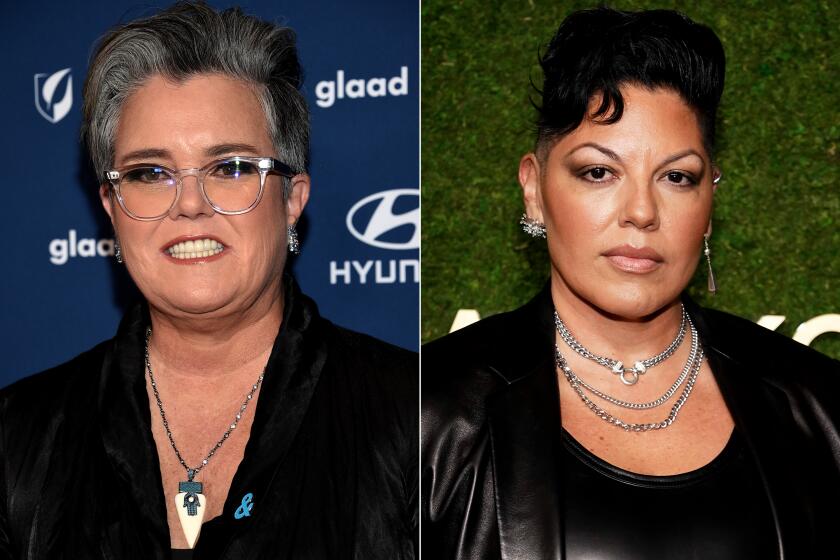‘Bear’s’ Cozy World Draws in Toddlers
Its universe draws you in, like a long forgotten scent from childhood that makes you feel right at home. A sunny place where life is experienced at a leisurely pace and innocence is regained through the healing influence of warmth and friendship.
It’s the world of “Little Bear,” the animated children’s series on Nick Jr., the morning programming block on Nickelodeon that’s designed for younger children. For the last five years, the show has captured the devotion of preschoolers--and many of their parents.
With a fifth season just about ready to go, and a direct-to-video movie scheduled for release next year, the show was nominated for a Daytime Emmy this year in the best animated children’s series category.
Based on the classic series of books from the late ‘50s and ‘60s written by Else Holmelund Minarik and illustrated by Maurice Sendak (of “Where the Wild Things Are” fame), the series is an anomaly in the hyperactive world of contemporary television. Its mood is so gentle and its iconography so unabashedly pastoral, it makes a lot of the other animated fare aimed at kids look like Quentin Tarantino movies by comparison. And yet, it is because of its emphasis on the cozier, most comforting aspects of existence that “Little Bear” has become such a hit with kids.
“It’s a very quiet show,” agrees Toper Taylor, president of Nelvana Communications, the company responsible for producing the series. “The story lines are extremely simple and have a gentle atmosphere about them. They create an environment that pacifies a child and pulls him into a warm and loving environment.”
The most remarkable aspect of “Little Bear” is its ability to catch the attention of grown-ups as well as toddlers. Taylor tells stories of adults he’s met who recite lines from specific episodes or start humming the theme song of the series as soon as they find out what he does for a living.
“Sendak will tell you that he doesn’t write children’s books,” he explains. “He just writes books that children happen to like, by creating an experience that is universal and evokes emotion.”
Unlike other shows of its kind, “Little Bear” has a unique structure that was clearly designed to accommodate a toddler’s limited attention span. The half-hour show is divided into three seven-minute segments presenting individual stories that are loosely connected by a theme. Some of the stories are faithful reproductions of the Minarik originals, yet because the first four seasons have included 52 episodes, a lot of fresh stories had to be written as well. Both Sendak and Minarik were closely involved in the creative process. Indeed, the characters retain the look of Sendak’s original drawings, and the artist supervises the visual texture of the series.
“We agreed with Sendak that there wasn’t going to be any magic or sorcery in the show,” Taylor recalls. “These animals are quite realistic, and there’s an overall familiarity with real-life situations.”
The show follows the adventures of a bear cub whose psychological makeup is remarkably similar to that of a 4-year-old human. He lives in a cottage hidden within a dreamy forest populated by animals who coexist in a blissful state of harmony. The world of Little Bear revolves around the two most important figures in his life: Mother Bear, who represents the idealized, ever patient parental archetype, and Father Bear, a brave fisherman who is often away from home. His frequent returns give his son the opportunity to understand that absence does not necessarily entail loss.
Bear’s friends include the mischievous Cat, the slightly neurotic Hen, the endearingly clumsy Duck, the self-important Owl and a sweet little girl by the name of Emily. These characters enjoy one another’s company and share their day-to-day life together. Although the story lines are devoid of the hyper-violent commotion that makes up most Hollywood movies, the world of “Little Bear” has its share of conflict.
“It’s not a sickeningly sweet show,” Taylor says. “It’s a show about characters growing up and trying to get along together. If you observe this carefully, you’ll notice that Duck is slightly nervous whenever he is a little too close for comfort to Cat. It is those subtleties that make the show unique.”
Still, the story’s central relationship is that of the cub and his mother. It is through her nurturing interaction with him that Little Bear finds the strength to go out with his friends and explore the world.
“The property was designed to create an environment that will empower the child,” Taylor says. “And that empowerment will not be dampened by parental force. The mother is there to allow Little Bear to live.”
In an implicit way, the stories also champion a return to a simpler, old-fashioned way of life that includes a closer contact with nature and the establishment of tightly knit communal relationships. Adults may find a slightly melancholy tinge to this idealistic vision that clashes head-on with a real world littered by excessive information, stimuli and consumerism. Like most successful works of children’s entertainment, “Little Bear” questions the very essence of adult society and its elusive quest for happiness.
“We look at ‘Little Bear’ in this electronically connected world and long for a moment in our life when things were simple and we had plenty of time to use our imagination,” Taylor reflects. “If that stirs melancholy feelings for the individual, so be it.”
*
* “Little Bear” can be seen weekdays at noon, and Tuesday to Friday at 9 a.m. on Nickelodeon. The network has rated it TV-Y (suitable for young children).
The complete guide to home viewing
Get Screen Gab for everything about the TV shows and streaming movies everyone’s talking about.
You may occasionally receive promotional content from the Los Angeles Times.



